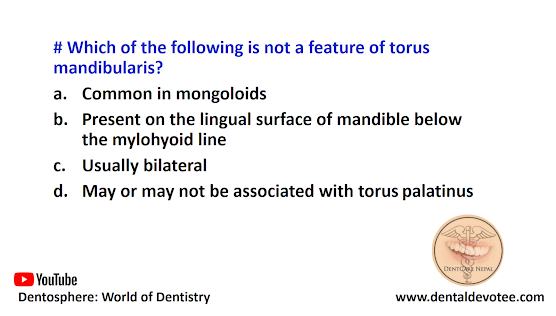# Which of the following is not a feature of torus mandibularis?
A. Common in mongoloids
B. Present on the lingual surface of mandible below the mylohyoid line
C. Usually bilateral
D. May or may not be associated with torus palatinus
The correct answer is B. Present on the lingual surface of mandible below the mylohyoid line.
The torus mandibularis is an exostosis or outgrowth of bone found on the lingual surface of the mandible. This growth on the lingual surface of the mandible occurs above the mylohyoid line, usually opposite the bicuspid teeth. Although the mandibular tori are usually bilateral, they are seen as a unilateral condition in about 20% of the cases. Both unilateral and bilateral protuberances may be single or multiple, and they are frequently visible on dental periapical radiographs. There is no correlation in the frequency of simultaneous occurrence of torus palatinus and torus mandibularis, according to the
studies of Kolas and coworkers, suggesting that the two conditions are not related. Suzuki and Sakai reported a highly significant correlation in the frequency of simultaneous occurrence of the two tori, however.


No comments:
Post a Comment
Add Your Comments or Feedback Here